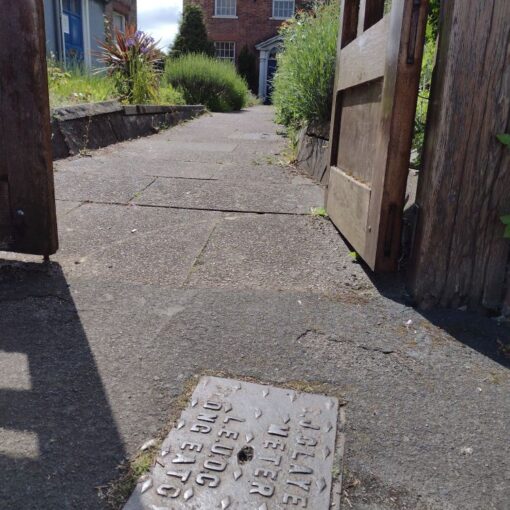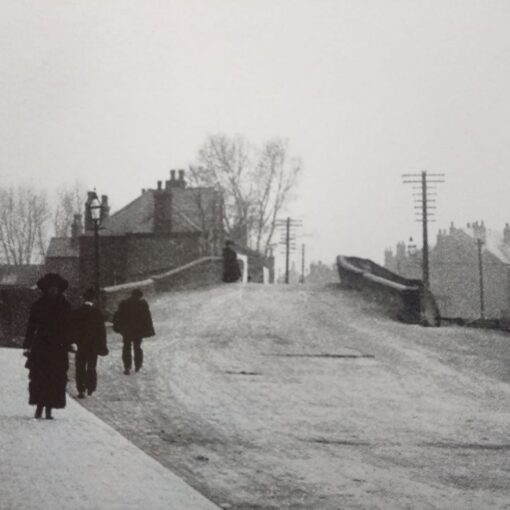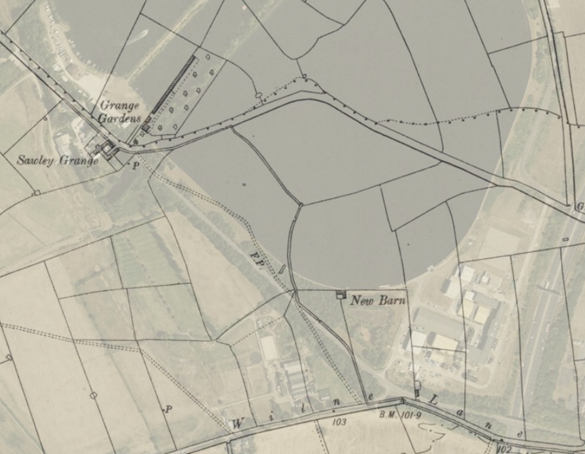
The Harriman Family
Grange Gardens were opposite Sawley Grange Farm, on the other (reservoir) side of Draycott Road, when it used to go to Draycott! Although always referred to as ‘Grange Gardens, Sawley’ it was (just) in Breaston parish.
The image above shows an 1890s map superimposed on a modern air photo. The story seems to start with the Harriman family …
Thomas Harriman was born in Hathern in 1812. He married Mary Frearson from Sawley in 1838. At first, they lived near Nottingham, but by 1846 they’d moved to Sawley Grange. Their children were:
- Annie (1842-1898)
- William (1844-1927)
- Elizabeth (1846-
- Mary (1848-1882)
- Grace (1851-1934)
Mary (the mother) died in 1851 probably while, or soon after, giving birth to Grace. In 1860 Thomas got married again, to Zillah Briggs.
By 1871 the family had moved to Draycott where Thomas worked as a brewery agent. But Thomas still owned over 12 acres of land, whilst the 3 younger daughters had just over an acre each (Annie was married by then). Elizabeth and Mary were still at home, both working as governesses. Grace (pictured) was probably living at home too, though she was away on the night of the 1871 census.
Thomas died in Draycott in 1877. By which time the 3 unmarried daughters had moved to Shrewsbury, where they ran the St Johns’ Hill School. Mary died in Shrewsbury in 1878, but Elizabeth and Grace stayed there until the mid-1880s.


By 1890 Grace and Elizabeth were living in Harrow (North London). Grace devised a scheme to employ ‘gentlewomen’ as market gardeners. She used society publications such as the Pall Mall Gazette and Strand magazine to publicise the scheme and attract ‘women of education and refinement’ (and money) who were willing to work. Grace claimed to have 400 applications, nearly all from the daughters of clergymen and military officers.
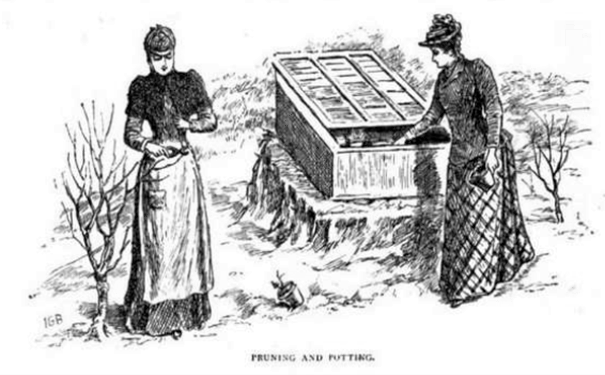
The location was sold as being near a mainline station (the original Sawley station) although it was just the land the Harriman girls already owned, being opposite their father’s old farm.
To become members of the ‘Ladies Fruit and Salad Garden Association’ applicants would pay a membership fee of 10 guineas each for the first year (about £1,130 in 2024 prices). This would cover tuition as well as board and lodging, although they would have to provide their own tools and furnish their own bedroom.
Six women would share a newly built house. Each member would have a ½ acre plot to farm. They would need to provide £100 (about £10,750 today) each to plant their own gardens. And a limited company would be formed to run a 99-year lease on their holding.
They would start with uncultivated meadow land, set up a garden and sell the produce, splitting any profits with the Harriman sisters.
They would grow fruit, salad crops, flowers and mushrooms. Men and boys would be employed to do work such as digging, manuring, and pruning. The women were expected to work long hours in summer but in winter they’d just be expected to look after greenhouses and chickens and would have a month’s holiday.
The plan was that the first 6 women (at Sawley) could become superintendents of other gardens as the scheme developed.
By Nov 1890 the first 6 gardening places were taken but Grace was offering space for more ladies to have a cottage on the grounds and pay their own board and lodging. Or to have board and lodging at a guinea a week and do as much gardening as they liked.
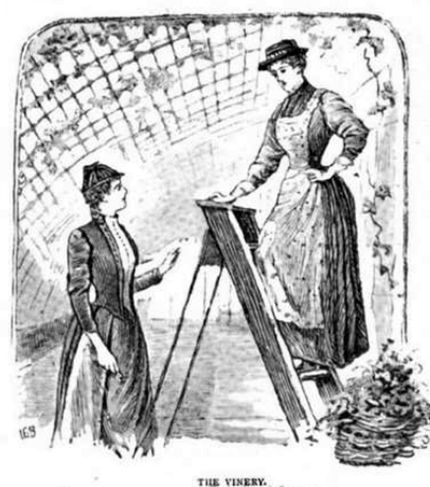
The Association members had to provide detailed accounts and received a percentage of profits in the first year, plus a salary from the limited company in subsequent years.
From April each year the gardens were open to visitors on Thursday afternoon, on payment of a shilling each.
Everything was regulated, including the menu and mealtimes, which were:
- Breakfast 8am
- Early Dinner 1pm
- Afternoon Tea 4pm
- High Tea 7pm
Grace would provide the tuition, but this seems to have been mainly done by post.
By April 1891 the first 6 women were living at Grange Garden. The oldest was Ellen Jane Bowley (47), a widow. There were two other widows in their 30s: Annie Jordan and Annie Steele. And 3 younger women: Mabel Symonds and Jane and Elizabeth Paterson Campbell.
By that summer things weren’t going well, and the company had not yet been formed. Grace wrote to Bessie Coles, the servant, saying ‘You may have to come here at a day’s notice bringing our silver and other portable things’ and telling her to burn the letter.
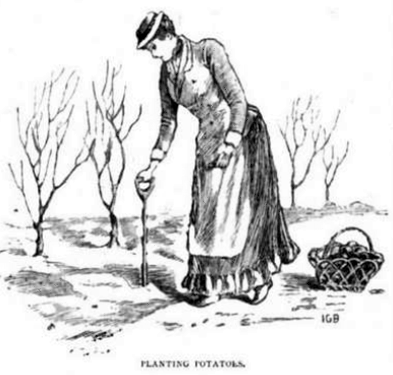
The Patterson sisters, who had been born in Jamaica, were daughters of a Scottish clergyman. They fell out with the others, but agreed to stay when Ellen and Annie Steele left.
But Elizabeth Paterson later sued, complaining about the accommodation, saying the water was too hard and the drainage was bad. The case was settled, and her 10 guineas were returned.
By 1893 Grace was trying to sell the contents of the house. By this time, she was living in Matlock and had a contract from Gloucestershire County Council to provide lessons in market gardening. She seemed to have quite modern (and forthright) views about horticulture and gave lectures around the country.
In 1894 Grace published ‘Tomato and fruit growing as an Industry for Women’. She was still promoting Grange Gardens but referring applicants to a Miss Cecil AJ Kerry at the farm. In 1895 the sisters were letting meadows for grazing, though it’s not clear if this was part of the ‘Garden’ or other land they’d inherited from their father.
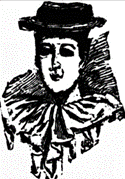
By around 1900 it seems there were two distinct properties opposite Grange Farm – Surmeadow and Grange Gardens, though it’s not clear if Surmeadow was a new house, or had been part of the Harriman ladies’ experimental farm.
Surmeadow
‘Surmeadow’ was a 3-bedroom house and poultry farm. The ownership/tenancy of which seems to have changed frequently.
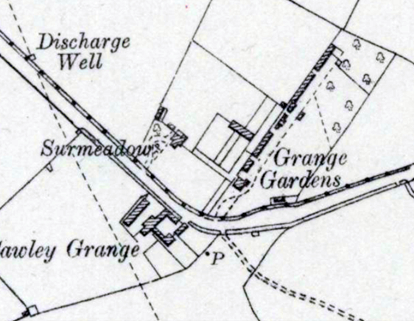
In 1901 A. D. Barnes was running the farm, but the house and 3 acres of land were put up for sale later that year. In 1909 it was for let again and Charles Andrew moved in. It was sold/let again in 1913 to Arthur and Sarah Pearson. They seem to have been replaced in early 1915 by John Cecil Marshall, but he sold up later that year when he was called up to the Army.
In the early 1920s it was occupied by Norman MacDonald, by 1928 it was John George Sheldon. In the early 1930s it was the Fowers family, but after their daughter died in 1936 it was put up for rent again, with 6 acres. Charles and Elsie McKlin were there in 1939, and then the Nash family after the war.
The last occupant was Peter Nash.
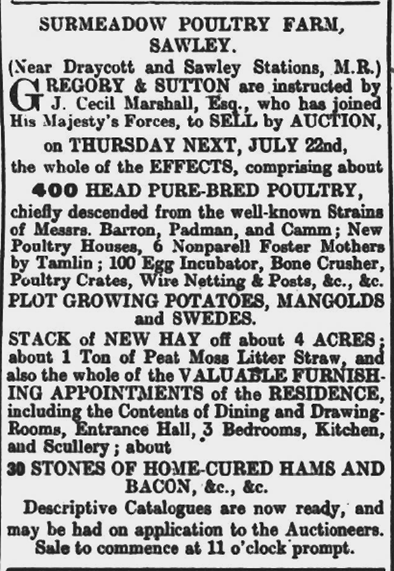
Grange Gardens (house)
By the early 20th century, ‘Grange Gardens’ consisted of a 5-bedroom house, a gardener’s cottage, and other outbuildings.
By 1911 it was owned by Arthur Williams – a coal merchant and market gardener. He put it up for sale the following year.
In 1921 Edwin Butterfield, a Long Eaton draper, was living there when he married Miss R Roper.
The last occupants were Malcolm Burrows and his wife.
The land associated with Surmeadow and Grange Gardens was lost when the reservoir was built in the 1960s. The buildings were presumably knocked down at the time. The site is now part of the Church Wilne Water Sports Club.
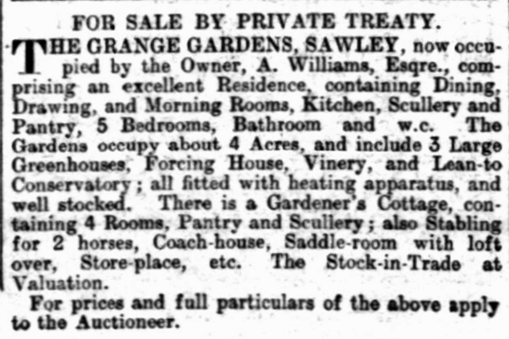
Postscript: the Harriman Sisters
In 1905, whilst living in Harrogate, Grace Harriman published ‘Successful Holding for Ladies: The Crucial Elements’.
In 1909 Elizabeth and Grace founded the ‘Gentlewoman’s Homestead Company Limited, with a capital of £1,300 in £1 shares.
The company bought land and buildings (from Grace!) at Kirk Deighton, near Wetherby. The object was to carry on a homestead for training gentlewomen in the art of poultry rearing, beekeeping, tomato growing and the cultivation of plants, flowers, fruit trees etc.
The sisters lived at the ‘Ladies Homestead for Gentlewomen’ at Kirk Deighton until in 1911, Elizabeth was filling a (methylated) spirit lamp in her bedroom to make tea, when the spirit spilt on her dress and caught fire. She died from burns two days later.
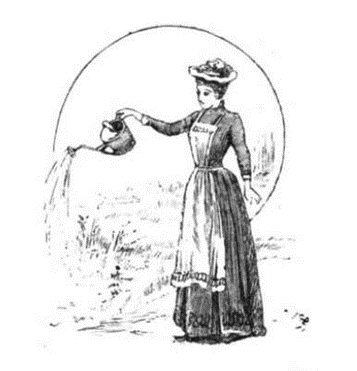
By 1916 Grace was living in Ockbrook, where she wrote another book; ‘Market Gardening for Ladies – The Way to Start Now’.
Sometime later, Grace moved from Ockbrook to The Court, Alvaston, where she died in 1934.

